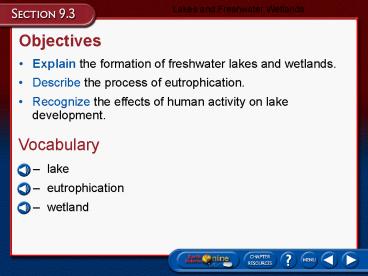Objectives - PowerPoint PPT Presentation
1 / 13
Title:
Objectives
Description:
A lake is a depression in the surface materials of a landscape that collects and ... their water from precipitation and their waterlogged soil tends to be rich in ... – PowerPoint PPT presentation
Number of Views:18
Avg rating:3.0/5.0
Title: Objectives
1
Objectives
Lakes and Freshwater Wetlands
- Explain the formation of freshwater lakes and
wetlands.
- Describe the process of eutrophication.
- Recognize the effects of human activity on lake
development.
Vocabulary
- lake
- eutrophication
- wetland
2
Lakes and Freshwater Wetlands
Lakes and Freshwater Wetlands
- A lake is a depression in the surface materials
of a landscape that collects and holds water.
- Lakes accumulate water from streams and runoff
that flow into them, local precipitation,
springs, and other sources. - Most lakes have outlets from which water flows to
rivers and to the ocean. - Reservoirs are lakes made for the primary purpose
of storing water for a communitys use.
3
Origins of Lakes
Lakes and Freshwater Wetlands
- Natural lakes form in different ways in surface
depressions and in low areas.
- Oxbow lakes form when streams cut off meanders
and leave isolated channels of water. - Lakes can form when stream flow becomes blocked
by sediment from landslides. - Some lakes are remnants of prehistoric lakes that
have receded to lower-lying areas. - Moraine-dammed lakes formed when glacial moraines
dammed depressions gouged out by glaciers.
4
Origins of Lakes
Lakes and Freshwater Wetlands
- Natural lakes form in different ways in surface
depressions and in low areas.
- Cirque lakes form when cirques carved high in the
mountains by valley glaciers fill with water.
- Kettle lakes formed when blocks of ice left on
the outwash plain ahead of melting glaciers
eventually melted and left depressions that
filled with water. - Some lakes are formed when the ceilings of
limestone caverns collapse leaving depressions
that fill with water.
5
Lakes Undergo Change
Lakes and Freshwater Wetlands
- A depression that receives more water than it
loses to evaporation or use by humans will exist
as a lake for a long period of time.
- Lakes are temporary water-holding areas.
- Over hundreds of thousands of years, lakes
usually fill in with sediment and become part of
a new landscape.
6
Lakes Undergo Change
Lakes and Freshwater Wetlands
- Eutrophication
- The amount of dissolved oxygen helps determine
the quality of lake water and its ability to
support life. - Eutrophication is the process by which lakes
become rich in nutrients from the surrounding
watershed, thereby resulting in a change in the
kinds of organisms in the lake.
- Although eutrophication can be sped up with the
addition of nutrients, such as fertilizers, that
contain nitrogen and phosphorus.
7
Lakes Undergo Change
Lakes and Freshwater Wetlands
- Freshwater Wetlands
- A wetland is a land area that is covered with
water for a large part of the year.
- Wetlands include environments commonly known as
bogs, marshes, and swamps.
- Bogs receive their water from precipitation and
their waterlogged soil tends to be rich in
Sphagnum, also called peat moss. - Freshwater marshes frequently form along the
mouths of streams and in areas with extensive
deltas. - The constant supply of water allows for the lush
growth of marsh grasses.
8
Lakes Undergo Change
Lakes and Freshwater Wetlands
- Freshwater Wetlands
- Swamps are low-lying areas often located near
streams.
- Swamps may develop from marshes that have filled
in sufficiently to support the growth of shrubs
and trees. - Swamps that existed 250 million years ago
developed into present-day coal reserves.
9
Lakes Undergo Change
Lakes and Freshwater Wetlands
- Freshwater Wetlands
- Wetlands serve as a filtering system that traps
pollutants, sediments, and pathogenic bacteria
contained in water sources.
- Wetlands also provide vital habitats for
migratory waterbirds and homes for an abundance
of other wildlife. - From the late 1700s to the mid 1980s, the
continental United States lost 50 percent of its
wetlands.
10
Section Assessment
Lakes and Freshwater Wetlands
- 1. What is eutrophication?
Eutrophication is the process by which lakes
become rich in nutrients from the surrounding
watershed, thereby resulting in a change in the
kinds of organisms in the lake.
11
Section Assessment
Lakes and Freshwater Wetlands
- 2. Why are lakes temporary water-holding areas?
Lakes are temporary water holding areas because
over hundreds of thousands of years , they
usually fill in with sediment and become part of
a new landscape.
12
Section Assessment
Lakes and Freshwater Wetlands
- 3. Identify whether the following statements are
true or false.
______ Oxbow lakes are remnants of prehistoric
lakes that have receded. ______ Lakes cannot be
located high in mountains. ______ The dissolved
oxygen level is a good indicator of the quality
of a lakes water. ______ Swamps that existed
250 million years ago developed into present-day
coal reserves.
false false true true
13
End of Section 3































